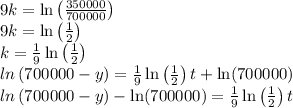
Mathematics, 16.06.2020 18:57 chart9968
Suppose that news spreads through a city of fixed size of 700000 people at a time rate proportional to the number of people who have not heard the news.
(a) Formulate a differential equation and initial condition for y(t), the number of people who have heard the news t days after it has happened.
No one has heard the news at first, so y(0)=0. The "time rate of increase in the number of people who have heard the news is proportional to the number of people who have not heard the news" translates into the differential equation
\frac{dy}{dt} = k (),where k is the proportionality constant.
(b) 9 days after a scandal in City Hall was reported, a poll showed that 350000 people have heard the news. Using this information and the differential equation, solve for the number of people who have heard the news after t days.
y(t) =

Answers: 1


Another question on Mathematics

Mathematics, 21.06.2019 16:30
Graph red beads cost $1 an ounce and gold beads cost $3 an ounce. juanita wants to purchase a 12-ounce mixture of red and gold beads that she can sell for $2 an ounce. the solution of the system shows the number of beads needed for juanita to break even. x + y = 12, x + 3y = 24 how many ounces of red beads will juanita buy to break even? how many ounces of gold beads will she buy?
Answers: 3

Mathematics, 21.06.2019 18:00
How many glue sticks are in a basket containing 96 scissors, if the ratio of glue sticks to scissors is 19 to 57.
Answers: 1

Mathematics, 21.06.2019 19:10
Asystem of equations has 1 solution.if 4x-y=5 is one of the equations , which could be the other equation ?
Answers: 1

Mathematics, 21.06.2019 19:40
What is the range of the function? f(x)=-2|x+1|? a. all real numbers. b. all real numbers less than or equal to 0. c. all real numbers less than or equal to 1. d. all real numbers greater than or equal to 1
Answers: 2
You know the right answer?
Suppose that news spreads through a city of fixed size of 700000 people at a time rate proportional...
Questions






Mathematics, 03.03.2020 23:46

Mathematics, 03.03.2020 23:46





Mathematics, 03.03.2020 23:46

Mathematics, 03.03.2020 23:46

Arts, 03.03.2020 23:47

Mathematics, 03.03.2020 23:47

















